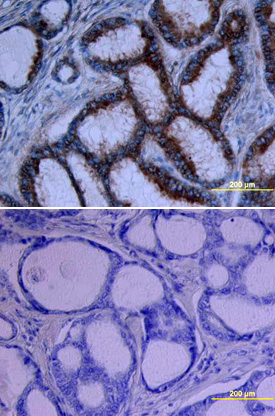Human Growth Hormone R/GHR Biotinylated Antibody Summary
Ala27-Tyr264
Accession # P10912
Applications
Please Note: Optimal dilutions should be determined by each laboratory for each application. General Protocols are available in the Technical Information section on our website.
Scientific Data
 View Larger
View Larger
Growth Hormone R/GHR in Human Breast Cancer Tissue. Growth Hormone R/GHR was detected in immersion fixed paraffin-embedded sections of human breast cancer tissue using Goat Anti-Human Growth Hormone R/GHR Biotinylated Antigen Affinity-purified Polyclonal Antibody (Catalog # BAF1210) at 15 µg/mL overnight at 4 °C. Tissue was stained using the Anti-Goat HRP-DAB Cell & Tissue Staining Kit (brown; Catalog # CTS008) and counterstained with hematoxylin (blue). Lower panel shows a lack of labeling if primary antibodies are omitted and tissue is stained only with secondary antibody followed by incubation with detection reagents. View our protocol for Chromogenic IHC Staining of Paraffin-embedded Tissue Sections.
Reconstitution Calculator
Preparation and Storage
- 12 months from date of receipt, -20 to -70 °C as supplied.
- 1 month, 2 to 8 °C under sterile conditions after reconstitution.
- 6 months, -20 to -70 °C under sterile conditions after reconstitution.
Background: Growth Hormone R/GHR
Growth hormone (GH), also known as somatotropin, is a member of a family of growth factors that includes prolactin, placental lactogens, proliferins and somatolactin (1, 2). It is synthesized primarily by somatotropes in the anterior pituitary and is released as an endocrine hormone. Other cells and tissues, including lymphoid tissues, can also produce GH (3). GH is a pleiotropic molecule which can act directly or indirectly via IGF-I, to regulate growth and metabolism as well as enhance T cell survival and thymic functions (1, 2, 4). GH exerts its biological actions by binding to the GH receptor (GHR) that is present in many cell types (1, 2). Human GHR cDNA encodes a 638 amino acid (aa) residue type I transmembrane protein with an 18 aa putative signal peptide, a 246 aa extracellular domain, a 24 aa transmembrane domain and a 350 aa cytoplasmic domain (5). At least two alternatively spliced isoforms of human GHR, lacking the sequence encoded by exon 3, or lacking most of the cytoplasmic domain, also exist (6, 7). Soluble GH-binding proteins corresponding to extracellular domain of the transmembrane proteins can be generated from the membrane proteins (8). Ligation of GHR by GH has been shown to result in receptor dimerization and activation of the JAK/STAT signaling cascade (9). The soluble GHBP has been shown to interfere with GH signaling by competing with the transmembrane receptor of GH. Alternatively, the GHBP has also been shown to enhance GH action by slowing GH clearance (8, 10).
- Goffin, V. et al. (1996) Endocrine Rev. 17:385.
- Le Roith, D. et al. (2001) Endocrine Rev. 22:53.
- Clark, R. (1997) Endocr. Rev. 18:157.
- Welniak, L.A. et al. (2002) J. Leukoc. Biol. 71:381.
- Leung, D.W. et al. (1987) Nature 330:537.
- Stallings-Mann, J.L. et al. (1996) Proc. Nat. Acad. Sci. 93:12394.
- Amit, T. et al. (1997) Endocr. Metab. 82:3813.
- Ross, R.J.M., et al. (1997) Molecular Endocrinology 11:265.
- Carter-Su, C. et al. (1996) Annu. Rev. Physiol. 58:187.
- Postel-Vinay, M.C. and J. Finidori (1995) Eur. J. Endocrinol. 133:654.
Product Datasheets
FAQs
No product specific FAQs exist for this product, however you may
View all Antibody FAQsReviews for Human Growth Hormone R/GHR Biotinylated Antibody
There are currently no reviews for this product. Be the first to review Human Growth Hormone R/GHR Biotinylated Antibody and earn rewards!
Have you used Human Growth Hormone R/GHR Biotinylated Antibody?
Submit a review and receive an Amazon gift card.
$25/€18/£15/$25CAN/¥75 Yuan/¥2500 Yen for a review with an image
$10/€7/£6/$10 CAD/¥70 Yuan/¥1110 Yen for a review without an image

